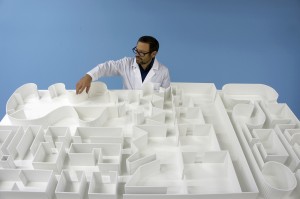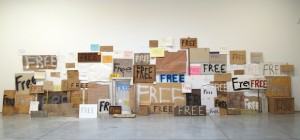You have no items in your cart. Want to get some nice things?
Go shopping
Utopia is an alluring yet troublesome concept. Since the term was first committed to print in 1516 by Thomas More, it has signified both a “good place” and “no place”: a dream destined to fail by virtue of its impossible desires.
Despite this inauspicious beginning, countless visionaries (and fanatics) have embarked on utopian ventures over the past half-millennium, constructing a compelling record of the many resourceful and innovative ways in which humans have tried to better their condition. Our ongoing cultural fascination with utopias suggests that these attempts to attain the ideal are interesting because of their faults, rather than in spite of them: ambitious proposals make glorious ruins.
The artists assembled for Whitechapel Gallery’s The Spirit of Utopia have recast utopianism as a user-friendly, grassroots form of Relational Aesthetics. They make no claims towards grand narrative shifts or cultural revolution. There are no dazzling dreams of new technological frontiers or higher levels of consciousness, and certainly no totalising plans for an ideal social order. Instead, the exhibition focuses on humbler propositions for improving social, economic and environmental relationships: suggestions that are utopian in spirit, if not in scale. Perhaps this is reflective of the current social climate, which is characterised by both widespread dissatisfaction with existing economic and political structures, and scepticism towards anything that claims to provide a “global solution”.
Theaster Gates’ Soul Manufacturing Corporation is a makeshift pottery studio in which professional artisans pass on skills to apprentices, fusing processes of labour and learning, art making and factory production. The studio’s output comprises small pots, bowls and bricks, both functional and aesthetically intimate: Gates connects making as a creative and personal act, to the making of tools for survival and daily life. Soul Manufacturing Corporation is an ongoing project, and each manifestation is adapted to reflect local communities and histories. Here, the inclusion of bricks references the 15th century manufacturing trade from which nearby Brick Lane takes its name: like many of the works in this exhibition, Soul Manufacturing Corporation is as much a look to the past as it is a look to the future.
Improbable Botany, Wayward Plants’ series of “experimental greenhouses” features the smooth white surfaces, transparent plastics and neat, stylised graphics of Modernist futurism. The displays are lacking the imaginative fusion of fiction and fact that most likely characterised the early part of the project: a collaboration with local school children to plant seeds during different stages of the lunar cycle, and — if I have interpreted the small accompanying booklets of children’s drawings correctly — foster environmental debate through invented tales of moon farmers and carrot-shaped robot thieves.
Claire Pentecost’s Old Friends and Unloved Others also focuses on the environment and food production processes, framing contemporary concerns over agricultural sustainability through anachronistic display systems (bell jars, apothecary bottles) and do-it-yourself techniques (composting, soil chromatography). A series of soil tests — circular stains of concentric chocolate and tan, like cross sections of newly made tree stumps — transform scientific data into a beautiful though illegible code. Pentecost’s “soil apothecary”, however, is overly reliant on nostalgia and nice antique surfaces, and lacking in context and application. The viewer is presented with the raw data, but not the means to analyse it.
Neither Improbable Botany nor Old Friends and Unloved Others assert radical stances — agricultural astrology and polyculture are practices dating back thousands of years — and both give the viewer only limited information with which to interpret the carefully arranged experiments. This points to one key flaw of the exhibition: many of the projects are presented without the transparency of research or process that would lend credibility to their ideas.
Similarly, many of the works founded on notions of inclusivity and community engagement are here stripped of opportunity for public interaction. One notable exception is Pedro Reyes’ Sanatorium, a series of rooms in which non-professional “counsellors” administer unusual group and individual treatments combining the theatrical and the pseudo-therapeutic. The therapies that allow “patients” to throw things around the room are particularly enjoyable.
The standout works in The Spirit of Utopia are also the simplest — in form, not in content. Peter Liversidge’s typewritten proposals to the exhibition curators inject some much-needed humour and personality. Each framed, single sheet letter puts forward an prospective act that may or may not be realised. Suggestions range from the whimsical (“I propose to bruise all the apples in all the shops in London”) and philosophical (“I propose to investigate coincidence”; “I propose to keep looking”) to more elaborate and ambitious proposals involving snow machines on the gallery roof, the Metropolitan Police’s forensic service, tree houses and dance choreography. The proposals operate in the space between intention and action, and can be seen as prototypes for broader systems of collaborative exchange.

- Peter Liversidge, Free Signs, 2010/11. Courtesy of the artist, Sean Kelly (New York) and Ingleby Gallery (Edinburgh).
Like Gates’ studio, Time/Bank’s Notes for a Time Bank reworks a past system to fit contemporary times. This installation of assorted research paraphernalia revives the short-lived attempt in 1827 by American anarchist Josiah Warren to establish a system of time-based currency. Warren’s Cincinnati Time Store issued notes inscribed with hours of labour and their equivalency in material goods; Time/Bank (initiated in 2009 by e-flux founders Julieta Aranda and Anton Vidokle) operates an online listings board where members can exchange hours of time for skilled work. Upscaled “hour notes” are pasted to the gallery wall, offering everything from horse exercising to Spanish lessons and a personal tour of the Kremlin. An accompanying video essay merges dislocating audiovisual components with a textual narration exploring concepts of time and space as measurements of human experience, shifting in dimensions and value to reflect our changing perceptions.
The Spirit of Utopia calls us to draw on human resources and interactions and employ dreams, stories and playfulness to imagine alternative systems of production and consumption. The sentiment is admirable, but the overall effect of the show is somewhat underwhelming. Many of the exhibits are part of larger projects that operate within a community context outside the gallery space, with specific social, political or environmental agendas. The dynamic and participatory nature of such projects can be difficult to translate into static displays. Fortunately, the exhibition is accompanied by an events series — and with a full and varied schedule to engage with, The Spirit of Utopia may yet come alive.
About Marianne Templeton
An Australian-born, London-based arts writer, curator and artist.




